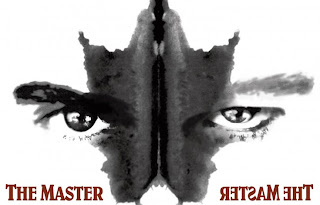Much has been written about Paul Thomas Anderson's new film The Master. It's a warp and weft of images, sounds and words that weave a series of feelings: alienation, disgust, ennui, sadness, and unnamable ones that flicker in and out of the edges of one's mind as the film unfolds. It's a strange experience. Quite long stretches are boring.. And yet, and yet, I have been thinking about the film for days.
There's no traditional story arc, even though it's chronological. In fact, you wonder if all the characters are really aspects of the same mind. It's flat. The film doesn't give you the satisfaction of having a beginning, a middle and an end. It's more along the lines of a play by Samuel Beckett, in which everyone just is. The movie divides in half, and the second half is a reflection of the first. It spreads out from the middle, like the Rorschach test which features on the poster. Neptune is a mirror.
If you want to see the less edifying side of astrological Neptune, this is the movie. It's full of Neptunian imagery from the opening sequence, which is simply the wake of a boat. It's a tale of dissolution, the search for oblivion, depravity: all themes of the sea lord. The central character is an ex-navy cadet, a drifter, who is a bundle of addictions and compulsions. After leaving the navy, his life is a in a nightmare version of On The Road. He has two talents, both of which are ruled by Neptune, making crazy cocktails – paint thinner, aspirin, and anything alcoholic – and taking photographs.
This sinner is Freddie Quell (Fred Equal, geddit) and it seems he will be rescued by Lancaster Dodd (which rhymes with God). Disciple and guru. Dodd embodies another set of Neptunian archetypes: mystic, charlatan.. Both men are alcoholics, bound together by drink. As Liz Greene explains in her book Neptune and the Quest for Redemption, there is a side to Neptune energy which is Dionysus was the god of wine and revelry, and also the god of insanity. This is a film about losing your mind.
 |
| Lucifer by Gustav Dore. Freddie Quell is so base it's almost impossible to believe he was ever an angel. Yet maybe we were all born angels. |
When there is no spiritual dimension to a person's world, the dark side of Neptune can swallow him up. Joaquin Phoenix, who has a stellium (Sun, Mars, Venus) in Scorpio trining Jupiter in Pisces, gives an intensely felt and compassionate performance as Freddie Quell. It's painful and ugly to watch this half-man trying to locate his humanity and his soul in the wreck of himself. Phoenix's (what an appropriate name for a Scorpio) Neptune conjuncts his South Node in Exaggitarius.
Philip Seymour Hoffman, who plays Dodd, has Chiron the wounded healer, at the final degree of Pisces, Neptune's own sign. That is at the last degree of the last sign, so all that symbolism is emphasised. His character in the film is attempting to heal. He is both snake-oil salesman and healer. His Mars conjuncts Phoenix's Mars-Venus in Scorpio.
Paul Thomas Anderson, the director and writer, has Sun in Cancer trining his actors' Mars. This is all very watery: vague, emotional, profound, visionary. Truly this is a film that tells the truth elliptically. Anderson's Mars is also in Cancer conjuncting Hoffman's communicative Mercury. This film is about Mars in water: masculine emotions, men drowning, sailors, castration.
The first action in the movie is the symbolic castration of a coconut tree followed by ritualised sex with a woman made of sand, and a man wanking into the sea. (It's a bunch of sailors at the end of WWII.) Seed spent on nothing.
 |
| Card 6 in the Rorschach test is known as a "sex card" |
An important scene in the film is the Rorschach test in which all Freddie can see is vagina, the place which is both the source of life and the swallower of seed.
The person with the real cojones in this film is Peggy Dodd, played with terrifying brilliance by Amy Adams. Her Saturn (strength) conjuncts Anderson and Hoffman's Cancer planets in Cancer, the sign of motherhood. She is pregnant for most of the film, the embodiment of feminine power.
Neptune, the planet of cinema, has returned to its own sign for the first time since the birth of photography. We should be seeing some wonderful movies over the next few years. The Master was released with Neptune at 1° Pisces opposite Mercury, and close to a conjunction with PT Anderson's North Node. This film about seekers exposing the emptiness of a life without faith is a pivotal moment in his career.

